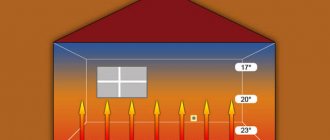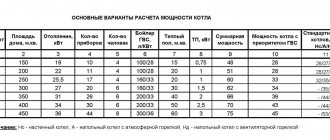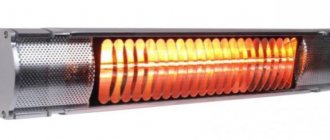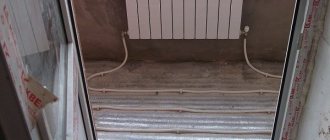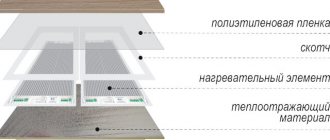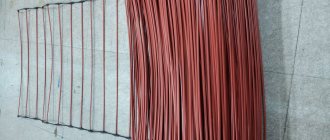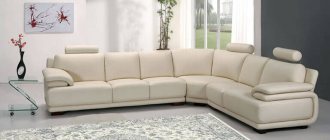Pipeline installation options
In practice, 4 heating circuit installation schemes are used: snail, corner snake, snake and double snake. In this case, the corner snake and just the snake are laid using sequential technology, and for this reason, in one part of the room the floor will be warmer than in the other. These two options are used only for small rooms.
As for the snail and double snake, these schemes provide for the proximity of parts of the circuit with hot water and a slightly cooled coolant, as a result of which thermal energy is distributed more evenly over the floor surface.
Factors that determine the power of a heated floor
The choice of device power is influenced by many reasons that must be taken into account in order for the heating system to work efficiently.
Climatic conditions also play an important role. If the house is located in a region with a cold climate, then the performance of the heating system should be selected with a reserve.
Main heating or not
One of the factors that influences power is the type of heating, that is, the system will be the main source of heat or an additional one. If this is the main heating system, then a device with higher performance is required, the required level of power density is 200 W per m2.
Each type of heating floor has its own standard thermal power per square meter:
- cable - 220 - 230 W;
- cable mats - 100 - 160 W;
- infrared film - 130 - 230 W;
- rod - 130 - 160 W;
- water - 40 - 150.
Type of room and its size
Each room in the apartment has its own function, depending on which the temperature indicator is determined. In addition, the temperature is affected by the area of the room and the number of window openings.
For example, the power of a heating system installed on a loggia should be higher than that intended for the kitchen.
In most cases, manufacturers of electric floors provide recommendations on these parameters:
- bathroom - 150 to 180 Watt/m2;
- glazed balcony - 150 to 180;
- kitchen, bedroom, corridor - 110 to 150.
When determining the power of underfloor heating depending on the size of the heated room, there is no need to take into account areas where heavy furniture will be located, since installing heating underneath it is not recommended. Naturally, the smaller the area of the room, the less efficient a heater will be required.
In addition, thermal conductivity is affected by the material from which the house is made - wood, brick, concrete.
Flooring
The heating power indicator largely depends on the finish coating. After all, the material has different degrees of thermal conductivity.
When using a heated floor under a laminate, the cost of heat resources will increase, since this material is a poor heat conductor. If you use carpet or linoleum, heating will occur faster, which will lead to saving thermal energy.
Thermal insulation of the room and heat losses of the building
Thermal insulation of a house, on which heat loss largely depends, is one of the most important factors in determining the power of a heated floor per square meter. If the insulation is poor (windows, doors, ceilings), the system will work longer and consume more heat resources, and this will lead to increased costs.
In old panel houses, the wall thickness is only 10 - 15 cm. In such buildings, heat losses reach 50%.
| Temperature in degrees | Good insulation (W/m2) | Average | Bad |
| 18 | 40 | 70 | 110 |
| 20 | 47 | 77 | 117 |
| 24 | 90 | 120 | 160 |
You can make a rough estimate of the thermal insulation of a room yourself using an online calculator. According to modern SNIPs, the level of thermal protection should be in the range of 100 -130 W/m2.
It is recommended to carry out additional insulation of the floors on which the heating system will be installed so that the heat does not escape outside.
Type of installation
The method of installing a heated floor also affects the choice of its power. After all, its heat transfer depends on the thickness of the “pie”.
Installation methods:
- Cement screed is one of the installation options. The concrete solution is poured with a minimum layer of 30 mm. To ensure structural strength, polypropylene fiber or mounting mesh is laid on the thermal insulation, to which the heating element is attached. A concrete screed is poured on top. The thicker the concrete layer, the longer the warm-up time, but at the same time, heat accumulates, which increases the cooling period.
- Warm floor under tiles - often done on an old base. First, the cable is laid with a certain pitch, the smaller it is, the better. The heater is filled with tile adhesive, after hardening the tile is installed. This method provides good heat transfer.
- Dry installation under laminate - if it is impossible to pour a concrete screed due to the weight of the structure, then installation is carried out in grooves. In order for the temperature to be uniform over the entire surface, the grooves must have a depth of 10 mm, into which the heating element is placed. If the cable is high power - 180 - 200 W, then it is recommended to make the grooves 15 - 20 mm deep.
Thermostat type
Thermostat is a device that records signals from a temperature sensor. It is responsible for supplying electricity to the device and, if necessary, turns the heating on and off, which leads to resource saving.
How to choose the right power for a heated floor?
How to calculate
Experts determine the required power of an electric heated floor in different ways: if the floor is the main or only source of heat, values from 150 to 210 watts per meter are proposed; if additional – from 110 to 150.
In this case, you need to take into account:
- purpose of the room. The weakest heating is in non-residential premises, higher in living rooms, and even higher in bathrooms. The highest - warm loggias and verandas;
- placement of heating sections (about 70 percent of the entire area of the house; warm floors are not placed under stationary furniture);
- thermostat operation (manual control saves up to 30 percent of energy, automatic control – up to 70).
The formula for determining the amount of energy consumed looks like this: the recommended power for a given room is multiplied by the heated area (minus the “cold” areas under the furniture). From this amount you need to subtract 30-70 percent (depending on the thermostat model).
For each circuit, power and flow are calculated separately.
Electricity consumption calculation
When designing a heating system, as a rule, a drawing of the location of its elements is drawn up. Based on the plan data, it is easy to calculate the area of the heated floor. If the drawing has not been preserved, then we approximately assume the area of heated floors to be 70% of the total area.
Conventionally, the operating time of heated floors is taken at the rate of 6 hours per day
For a ground floor living space with an area of 20 m2, 14 m2 must be heated as the main source.
The specific power of a heated floor for this type of room is 150 W/m2. Accordingly, the electricity consumption for the underfloor heating system will be: 150 * 14 = 2100 W.
Conventionally, the floors are turned on for 6 hours per day, then the monthly rate will be 6 * 2.1 * 30 = 378 kW/hour. Multiply the resulting number by the cost of 1 kW in the region and get the cost of electricity costs in a given room.
If you include a thermostat in the heating system and set the operation to an economical mode, the energy consumption of floors can be reduced by 40%.
It is more difficult to calculate the power of a water heated floor system; in these calculations it is better to trust an online calculator or consult with a specialist. To learn how to calculate power for film floors, watch this video:
Factors that reduce energy consumption
As already mentioned, when installing electric heated floors in all rooms of the apartment, the payment costs will be impressive, which will affect your family budget.
However, there are ways to reduce energy consumption:
- Carrying out high-quality insulation - good thermal insulation reduces consumption by 35 - 40%.
- Installing a multifunctional meter - the cost of electricity used at night is about 2 times lower. Moreover, heating mainly works when there are people in the house, and this is usually in the evening and night.
- Installation of heated floors should be carried out in a free area. Laying it under furniture is not only unprofitable, but also prohibited by the system manufacturer.
- Use of finishing coatings with a good degree of thermal conductivity.
- Installing a programmable thermostat, especially in residential areas, will allow you to save a third on energy.
- In sparsely inhabited rooms, not maintaining a high degree of heating is an unnecessary waste of energy.
Climatic conditions are also of great importance. The greater the difference between the temperature in the room and outside the window, the power consumption of electricity increases.
Thermostat is an indispensable device for reducing costs
Separately, it should be said about the thermostat - its use can reduce energy consumption by up to 40%. It is recommended to install the device in the coldest place in the room. When the temperature drops below the set value, it will turn on the heating, and when the desired value is reached, it will turn off.
In many ways, electricity consumption is influenced by the type of thermostat, they are:
- mechanical - the design is simple and inexpensive, the daily working time is about 12 hours;
- programmable - equipped with several modes that allow you to control operation; such a device operates only 6 hours a day.
Using an example, we will consider which type of thermostat will be more economical. To do this we use the formula:
Рд = t * Ptot;
t—device operating time;
Ptot—power.
When installing a mat with a voltage of 900 W, and using a mechanical type regulator:
Pd = t * Ptot = 12 h * 900 W = 10,800 W = 10.8 kW
If a program controller is installed, then
Pd= t * Ptot = 6 h * 900 W = 5,400 W = 5.4 kW
From this calculation it is clear that the use of a programmable controller will significantly reduce your costs.
If the warm floor acts as the main heating in all rooms, then the installation of several regulators will be required, which are connected to one centralized system.
When thinking about installing an electric floor in a house or apartment, you should make all the required calculations, taking into account the maximum load in winter. Only after weighing all the pros and cons, you need to make a decision about installing such a structure.
Video materials
The video discusses in detail how much electricity Caleo underfloor heating consumes.
How to calculate the power of a water heated floor
The heat transfer of water floors directly depends on the length of the pipeline.
To calculate the system power you will need to know:
- area and configuration of the room;
- coolant consumption;
- heat loss;
- laying step.
Planning
Any calculation must begin with drawing up a floor plan. It is more convenient to do this on graph paper, but you can also do it on squared notebook paper. The drawing shows all the windows and doors of the room, indicating their sizes.
The height of the room is immediately measured and the useful volume indicators are recorded. The plan marks the areas where the furniture will be placed. Then you need to display the pipe layout.
Determination of area
When calculating the power of a water floor, you need to remember that the area under stationary furniture and appliances is not taken into account.
The area of the room is calculated using a standard formula (area of a square, rectangle, etc.), and the areas where the furniture will be placed are subtracted from the result.
Heat loss calculation
Heat loss is heat in quantitative terms that is lost by a room per unit of time. To reduce heat loss, heating devices are used, and good thermal insulation is also done.
When calculating heat losses, the following are taken into account:
- room area;
- size of windows and doors;
- ceiling height;
- number of external walls;
- outside temperature;
- thermal insulation of walls;
- the type of room that is located above.
To calculate heat loss, you can use an online calculator.
Coolant flow
To calculate water consumption, you will need to know how much coolant passes through the pipeline in 1 hour. We need this in order to correctly configure the rotameters and make the right choice of pump performance.
Water consumption is calculated using the formula:
G = 0.86 x Q / Δt
Where:
- G – water consumption in kg/h;
- Q – thermal power in W;
- Δt – temperature difference of the coolant in the supply and return circuits, for heated floors it is equal to 10 °C;
- 0.86 is the heat capacity coefficient of water.
Laying pitch and contour length
For underfloor heating, in private housing, metal-plastic or polyethylene profiles with a diameter of 16 mm are often laid. There are several ways to lay a pipeline - a snake or a snail, and the laying step should not be too small.
It is recommended to limit the length of each circuit to 80 meters. The choice of pump power depends on its size.
The length of the contour can be calculated using the formula:
L = F/b
Where:
- F is the area of the room;
- b - laying step.
If the length of the pipeline is more than 100 m, then it must be divided into several loops.
Floor power
The power of a water heated floor per 1 m2 is small, and is only 40 - 150 W. For the system to work effectively, the heat distribution over the surface must be uniform, without the formation of cold zones. To increase heat transfer, it is recommended to reduce the pipe laying pitch.
Is the underfloor heating enough to heat the house? Lifehack from Design.rf
Heat flow density is calculated using the formula:
Q=q/F
Where:
- q—heat loss index;
- F is area.
Boiler performance
How to calculate the power of a boiler for heated floors - this is done taking into account the power of the heated floors of the entire house. You should add up all the values that were calculated for each room.
You need to add 15% to the result obtained - this will be the required boiler performance. If you buy a boiler without a reserve, then at 100% load, the resource of the unit will be consumed as quickly as possible.
The productivity of modern boilers is 24 kilowatts, which is enough to heat an average room with an area of up to 240 m2. There are electric boilers, and with a built-in pump - which is very convenient.
Circulation pump
Without a pump, hydrofloors will not function effectively. How to calculate pump power for heated floors? It depends on the hydraulic resistance in the line; the longer the pipeline, the more powerful the pump is required.
To determine the pump performance, you can use the formula:
Q = 0.86*Pn/(trev.t - trev.t)
Where:
- Pн - power of the heating device in kW;
- trev.t - temperature indicator of the coolant in the return;
- tpr.t — temperature level in the supply.
It is recommended to choose floor designs that allow you to regulate power within large limits. When turned on, it should be at maximum, due to this the heating of the floors will be faster.
After reaching the specified parameters, the heating temperature should automatically decrease in the system.
Warm floor power calculation
The determination of the required power of a warm floor in a room is influenced by the heat loss indicator, to accurately determine which it will be necessary to carry out complex thermal calculations using a special method.
- The following factors are taken into account:
- heated surface area, total area of the room;
- area, type of glazing;
- presence, area, type, thickness, material and thermal resistance of walls and other enclosing structures;
- level of penetration of sunlight into the room;
- the presence of other heat sources, including taking into account the heat emitted by equipment, various devices and people.
The methodology for performing such accurate calculations requires deep theoretical knowledge and experience, and therefore it is better to entrust thermal engineering calculations to specialists.
After all, only they know how to calculate the power of a water-heated floor with the smallest error and optimal parameters
This is especially important when designing heated built-in heating in large areas with high heights
Installation and effective operation of a heated water floor is possible only in rooms with a heat loss level of less than 100 W/m². If heat loss is higher, it is necessary to take measures to insulate the room in order to reduce heat loss.
However, if the design engineering calculation costs a lot of money, in the case of small rooms, approximate calculations can be carried out independently, taking 100 W/m² as the average value and the starting point for further calculations.
- At the same time, for a private house it is customary to adjust the average rate of heat loss based on the total area of the building:
- 120 W/m² – for house area up to 150 m²;
- 100 W/m² – with an area of 150-300 m²;
- 90 W/m² – with an area of 300-500 m².
System Load
- The power of a water heated floor per square meter is influenced by such parameters that create a load on the system, determine the hydraulic resistance and the level of heat transfer, such as:
- the material from which the pipes are made;
- contour laying diagram;
- the length of each contour;
- diameter;
- distance between pipe strings.
Characteristic:
The pipes can be copper (they have the best thermal and operational characteristics, but are not cheap and require special skills and tools).
There are two main contour laying schemes: snake and snail. The first option is the simplest, but less effective, as it produces uneven heating of the floor. The second one is more difficult to implement, but the heating efficiency is an order of magnitude higher.
The area heated by one circuit should not exceed 20 m². If the heated area is larger, then it is advisable to split the pipeline into 2 or more circuits, connecting them to a distribution manifold with the ability to regulate the heating of floor areas.
The total length of the pipes of one circuit should be no more than 90 m. Moreover, the larger the diameter chosen, the greater the distance between the pipe strings. As a rule, pipes with a diameter of more than 16 mm are not used.
Each parameter has its own coefficients for further calculations, which can be viewed in reference books.
Heat transfer power calculation: calculator
To determine the power of a water floor, it is necessary to find the product of the total area of the room (m²), the temperature difference between the supply and return fluid, and coefficients depending on the material of the pipes, flooring (wood, linoleum, tiles, etc.), and other elements of the system .
The power of a water heated floor per 1 m², or heat transfer, should not exceed the level of heat loss, but no more than 25%. If the value is too small or too large, it is necessary to recalculate by choosing a different pipe diameter and the distance between the circuit threads.
The higher the power indicator, the larger the diameter of the selected pipes, and the lower, the larger the pitch between the threads. To save time, you can use electronic calculators for calculating a water floor or download a special program.
Let's calculate the power of an electric heated floor
Before calculating the power of a warm electric floor (heating cable, mat, infrared system), you need to find out whether the network can withstand the additional load, and make a project. Also decide whether he will:
- main - 150 - 220 W/m2;
- additional - 110 - 150.
It is recommended to install heated floors with heat losses of no more than 100 W per m2. If the indicator is higher, then an additional heating system is needed.
All electric floors, except for the self-regulating heating cable, are not installed under heavy furniture, as these systems are afraid of overheating.
Therefore, as with water heating, in order to calculate the power of the device, you must first draw up a furniture arrangement plan. That is, you need to calculate the area that will be heated.
Let's take a room with an area of 20 m2. From this value we subtract the area that the furniture will occupy - 8 m2, resulting in a heated area of 12 m2.
In general, it is correct to calculate the power of the system not by area, but by volume, since heating more air requires more energy.
The choice of heat transfer for electric floors is also influenced by heat loss. These calculations are quite complex, so you can use tables that are available in specialized literature or on the Internet. Of course, the values indicated there are averaged.
Manufacturers indicate the power of electric heated floors per 1 m2 on the label. It looks like this: 220v/50-60hz/50cm/55w, that is, the floor operates at a voltage of 220 W, and emits 55 W of heat from each square. If a resistive heating cable is used, then its performance is low, and it can be increased to 200 W per m2 by reducing the width of the turns.
Let's make a calculation using the example of calculating the maximum power of an infrared heated floor. We take the size of the heated area, which we defined above - 12 m2, and a standard film with a voltage of 220 W per 1 m2.
P = 12 m2 x 220 W = 2,640 W.
As a result, we find that our room will require a heated film floor with a total power of 2640 W.
Choosing the design of floor heaters
Whatever the heating design, the system must be warmed up to operate. And how quickly it reaches the set mode will depend entirely on the power of the “warm floor” per 1 m². And you need to start from the role of underfloor heating.
If this is the only source of heating the room, then you will need up to 200 W per square meter. When the “warm floor” only helps the main radiators, then the need can be reduced to half or one and a half times. And then 100-150 W per meter of housing will be enough.
Any of the “warm floor” designs has similar power. The owner of both an apartment and a country house can always choose a profitable system for himself. After all, any of them can save up to 15% of energy resources in comparison with radiator heating.
Cable circuit
A very common system because the material is inexpensive. True, in order to reduce inevitable heat losses, you will have to install either a reinforced screed or use self-leveling floors. But it will quickly pay off.
Cable circuit Source 1-teplodom.ru
The owner will have to choose from two cable options. Typically, single-core is used if a system is installed to assist the main heating. And in this case, you won’t have to worry too much about how much the electric “warm floor” consumes. Because the consumption will be minimal.
But if the system will completely and independently heat the room, then you need to take a two-core cable. This will prevent you from closing the loop on the thermostat during reverse operation. True, in this case you will have to work hard during installation to get 200 W per square meter. To do this, you need to lay the wire much tighter than usual.
Experts advise not to lay a contour under the furniture, and also not to cover the surface with thick carpets. Why greatly disturb heat exchange or heat objects rather than air. This will unnecessarily increase energy consumption. And so, you may need a lot of it, because for effective heating it is necessary to cover the room by at least 70%.
See also: Catalog of companies that specialize in home insulation
Cable mats
Manufacturers produce two types of designs. Some need to be placed under a concrete screed. But the latter should not be too thick. In this case, thin cables on a mesh will warm up the surface faster.
Mats with a hardened surface do not require screed. They have a layer of thermal insulation. And you can immediately install flooring on them.
Thermomat Source allelectrics.ru
Infrared film
The most productive system today. Because a film based on carbon material just 3 mm thick has an efficiency of up to 95%. And at the same time, energy consumption is very economical. Coatings are produced in various designs. Some need to be hidden under a thin screed, others can simply be covered with carpet.
Recently, the production of thermomats with carbon rods inside has begun. Such a heater is inferior in power to film, but can be successfully used as additional heating. The mat itself must be laid under the floor covering.
Electricity consumption per 1 m² of underfloor heating film system will be from 100 to 200 W per hour. The power of the rod can range from 70 to 150 W.
Types of heating elements
There are several types of electric heated floors, the power of which directly depends on the type of heating element. Electric floors work on:
| Heating element | Power (W/m2) | Finish type |
| Infrared film | 150 – 400 | Any |
| Electric cable | 120 – 150 | Ceramic tiles, porcelain tiles |
| Thermomat | 120 – 200 | Ceramic tile |
The data is taken as an average; indicators for a particular brand may vary slightly. Thus, it is clear that the installation of any heating system in a room of any type is possible with all options for electric heated floors.
Accurate calculation of energy consumption
Let’s calculate the maximum figure for how much heated floors consume using the example of a room with an area of 14 square meters in an ordinary “Khrushchev”:
The area of the heating area is 10 square meters.
Remember that it is enough to install a heated floor system on 70% of the total area of the room for sufficient heating.
- The system power will be 150 W per square meter. Now let's calculate the minimum power: 150 W multiplied by 10 m² and we get -1.5 kW.
- We will assume that the floor is constantly on. This means that he works 6-8 hours a day. multiply 8 hours by 1.5 kW and get 12 kW - the maximum energy consumption of the electricity system per day.
- We calculate how much will be consumed per month: multiply 12 kW by 30 and get 360 kW.
- 1 kW costs on average 2.5 rubles. So, we multiply 360 kW by 2.5 and get - 900 rubles.
The resulting amount is the maximum possible amount of energy consumption. If you turn off the heated floor while you are away or install a thermostat, costs will be significantly reduced.
Thus, the energy consumption of heated floors is not so high as to become a serious disadvantage and a reason for refusing to install them.
Installation and useful tips
The surface of the base is leveled with specialized compounds. Unevenness or sudden changes can damage certain areas.
Leveling the surface of the base screed
If the base is made of boards, it is recommended to level the horizon using fiberboard or plywood. In case of strong differences, the surface is planed entirely with electric jointers, or the places of the highest differences are planed with hand tools.
Standard kit:
- Thermal film;
- Connecting wire;
- Connection terminals;
- Insulating material.
Complete set of required materials
Note! The thermostat (control panel) is not always included in the standard kit; it is purchased separately.
One of the options for the external design of the thermostat
Depending on the floor covering, other components are selected.
Installation of infrared film heated floor under linoleum or carpet (video)
Some tips
Before calculating the heat transfer requirements, you need to consider some points. Initially, you need to determine the maximum thermal conductivity of the material that is located above the pipes, films and cables that act as heating elements. The efficiency of heat transfer depends directly proportional to the thermal power, and inversely proportional to the coating resistance.
Related article: Using blue wallpaper in the kitchen
All pipes and materials that will be located below the level of the heating element must have high thermal insulation. This will eliminate possible heat loss through the coatings. If installation and calculation are carried out correctly, the thermal insulation will block heat transfer and reflect thermal radiation.
The need for thermal power is determined by the thermal insulation and its quality. It is preferable to adhere to standards that will guarantee high performance and comfort.
Remember that if you have chosen a warm floor, you should not clutter it with massive furniture structures. This will not bring the desired heating result, and overheating and damage to furniture under the influence of temperatures is also possible.
An example of installing heated floors in a kitchen
Which underfloor heating system to choose
Water or electric heated floors - each has its own advantages and can create a comfortable atmosphere in the house.
The water one is installed more often in private homes, as it is cheaper than the energy-powered one. But installing it in apartments requires connection to central heating, and this is prohibited without permission.
In apartment buildings, preference should be given to electric types. You can take models with low power, since the apartments already have basic radiator heating.
If the design of the house allows it, and you plan to have floor heating in the screed, then the cable type is the best option. The mats are the easiest to install; you just need to spread them on the floor.
If the ceiling height does not allow, then infrared strip floors are suitable. Their thickness is only 3 mm. Heating is carried out by emitting infrared waves, which increases efficiency by 95%, so energy consumption is more economical. Yes, and such a system can be installed under any coating.
Nominal and real energy consumption of electric heated floors
Main types of electric floors
To determine the power consumption of a heated floor, you should consider the basic power of each type of material used during installation. The most common types are:
- film infrared coating;
- heating cable;
- thermomat
Classification of warm electric floors
For thin flooring, such as laminate or linoleum, film heating systems are most often used. For tiles and other hard materials - cable or mats. Film coating consumes the most electricity, heating cable is the most economical. Thermal mats are based on an infrared blanket, so their energy consumption indicators are similar to film ones.
Basic power of heating devices
The electricity consumption of each heating system depends on a set of characteristics:
- material thickness;
- power of devices per 1 sq. meter;
- maximum heating temperature.
Table of heat consumption of heated floors in rooms
The manufacturer is required to indicate this data on the original packaging of the material, as well as the nominal amount of energy consumed.
Table of power consumption of some models of heating elements per 1 sq. meter:
The cable has a small power, but it is placed in several turns per 1 sq. meter, so that the total power of the heated floor is 130–150 W per square meter - this is the average.
Power calculation for heated floors
Factors affecting power consumption
Total costs for underfloor heating systems
But there are other factors that can reduce or increase electricity consumption, these include:
- the level of thermal insulation of the walls in the room - the higher it is, the lower the energy consumption will be;
- outside air temperature - in the cold season, the electric floor will work much more;
Energy consumption calculation
In order to calculate how much electricity a heated floor will consume, there are several approaches:
Calculation of nominal consumption: in a room with an area of 14 m2, heating elements will occupy 10 m2. To calculate electricity consumption, you need to multiply the coverage area by the power.
Electricity consumption of infrared heated floors
Let's assume that a thermomat with a power of 130 W per 1 meter² is used, then 10*130 = 1300 W or 1.3 kW/h is the nominal consumption. Further, we assume that the floor is turned on for 8 hours per day, then per day it turns out - 8 * 1.3 = 10.4, and per month - 10.4 * 30 = 312 kW.
The average cost of 1 kW in Russia is 2.5 rubles, so the cost of operating a heated floor will be 780 rubles. This method makes it possible to calculate the maximum amount of energy consumption, without taking into account the use of a thermostat and other factors affecting consumption.
Technology for calculating costs using a coefficient.
The formula used for calculation is: W=S*P*k, where:
Graph of heating and electricity consumption of infrared heated floors
S – room area;
P – heating element power;
k is the coefficient of useful heating area, according to generally accepted standards it is equal to 0.4.
A room with an area of 20 m2, a thermomat with a power of 130 W per 1 meter² is used, then the formula will be as follows:
W= 20*130*0.4 = 1040 W (1.04 kW).
Next, we calculate the electricity consumption per day: 8 hours * 1.04 kW = 8.32, per month - 12 * 30 = 249.60 kW. Cost of expenses – 249.60*2.5 = 624 rubles.
Electricity consumption of infrared film
How different are the actual energy consumption figures from the nominal ones?
Of course, the actual consumption will be very different from the nominal values, since it often happens that there is no one in the house all day and there is no point in turning on the floor, so in reality it will only work for 5 hours. There will also be no need for daily heating, especially in warm autumn, late spring and summer, so the calculated figures will be approximately two times lower.
Correct installation of electric heated floors
There are also ways to significantly reduce power consumption, for example, using a thermostat. A good device will save up to 30% of the nominal energy consumption. In practice, it turns out that the electric floor heats up to the set temperature in 5 minutes, then cools down for 10 minutes and turns on again. The heating element only works for 20 minutes per hour. If the entire system is turned on for 9 hours a day, only 3 hours of which electricity is consumed, therefore the costs will look like this:
W= 20*130*0.4 = 1040 W/h (1.04 kW);
1.5*3 = 3.12 – per day;
3.12*30 = 93.60 – per month;
93.60*2.5 = 234 rubles.
There are several other ways to reduce energy consumption:
Thermostats
The thermostat is a device that turns on floor heating in rooms when the temperature decreases to a set value. The specified temperature is user adjustable. When it is reached, the system turns off and turns on again only after cooling.
The thermostat is equipped with a sensor with which it receives information about the temperature conditions. The specified device should be hung in the room in the coldest place.
There are the following types of thermostats:
- Mechanical. The cheapest and easiest to use devices that are self-contained.
- Electronic. They are equipped with special displays that display all available settings. The device receives temperature information using a temperature sensor (which can be internal or external), after which it adjusts the time the heating is turned on, thereby allowing it to consume half as much energy.
- Programmable. A separate category of electronic thermostats. They have a lot of additional options that allow you to make narrow settings.
- Sensory. The most advanced version, which allows you to customize the operation of the system taking into account numerous factors and details.
In order for heated floors to work effectively, it is necessary to approach their installation with all responsibility. How much less energy they can consume depends on various factors, including heat loss and the presence of a thermostat.
Calculation of heat transfer for a film heater
The rated power in this case is 150-220 watts. You need to understand that the film heater itself is a layer of foil insulation for the pipe. It is made of foamed polyethylene, the surface of which is covered with foil. Because of this, some of the heat is dissipated, because efficiency depends on thickness.
To set the temperature of a standard or water floor in a given range, thermostats are used. The value usually does not reach 40 degrees, and after use it is necessary to turn off the element and give it time to cool. It follows from this that the heat transfer is about 70 watts per square meter.
Article on the topic: Furniture blinds: advantages, types, making your own
